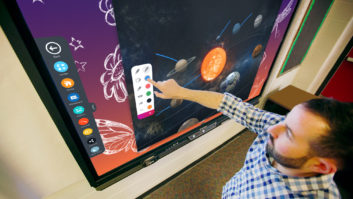
Paul Depperschmidt is well placed to comment on the effects of AV-IT convergence on the world of the integrator. A 25-year industry veteran with a background in video communications, he spent eight years at Polycom before moving to Tandberg, the latter being acquired by Cisco in 2010. Much of his career has been involved with working with channel partners, although he has also spent time in sales and management for integration companies and manufacturers. So he’s seen the sales process from many sides, and watched it evolve, over an extended period of time.
He observes: “I think every manufacturer with a channel programme ought to have someone who worked at a partner for a little while – it’s just a different world on that side of it. If you have an appreciation of what they do every day it’s a lot easier to tailor your programmes around them.”
He describes the move to Cisco as “the biggest upheaval” of his career – and he has seen “drastic changes” in the role of the AV integrator over the past three years.
“For as long as I had been in the industry, video codecs that we sold into integrated conference rooms were exclusively the realm of the AV integrator.” So he would present codecs to integrators and, once they were convinced these were right for the project, the integrators would specify them. “The end user typically didn’t know or care what codec they were using.”
Now, when companies like Cisco or Microsoft are involved, “the integrator may be at the tail-end of the process, and not necessarily driving that decision any longer”. Instead, large corporations may buy their Cisco endpoints from the Cisco partner that has also sold them their network infrastructure. “So it’s not just the technology that has changed over the last three years – it’s the go-to-market.”
While he obviously can’t speak for Microsoft, he believes that company is set to have a similar impact to Cisco on the AV space. “They’re going at it from the computer and the desktop, while we’re going at it from the network standpoint. It’s going to be an interesting world – there are two behemoths going at each other here. Sometimes we work together, sometimes we compete, but it’s the nature of the world now that the underlying architecture everything runs on is the key.”
Cisco is migrating its video communication offerings from “the old Tandberg VCS world” into the collaboration world – with greater scalability and improved functionality in areas such as telephony, video, mobile, instant messaging and presence. Meanwhile, Microsoft is pushing Lync as its underlying architecture. “So the AV integrator is facing the battle of the behemoths; now you have two major players promoting their own versions.”
That’s not all that has changed. In the “old world”, vendors employed a ‘top-down’ strategy: customers had large, dedicated room systems installed first, and the expectation was that “once the C-level guys saw video working they would love it so much that they would push it to the rest of the organisation”. In fact, because the market wasn’t ready, “it never got past the mid-level”. Today, driven by the use of video in our daily lives on PCs, smartphones and tablets at a very low cost, “the strategy has been reversed – it’s now much more bottom-up”.
This has had at least three ramifications. First, prices are falling. For instance, ahead of InfoComm, Cisco introduced the SX10 Quick Set – an all-in-one video codec solution that just needs the addition of a display to video-enable a small collaboration room – for less than $4,000 (retail), so integrators can fit out a room, with monitors, for around $5,000.
Second, the demand profile is moving downwards. “A large enterprise would be much more willing to put in 100 huddle rooms at $5,000 or $10,000 fully installed, than four or five $150,000 rooms,” he says. “It’s not that they won’t need the big rooms, but they’re going to do a lot more of the small rooms.”
Third, Depperschmidt is seeing a trend in which functionality is being traded for simplicity of operation. “You can walk into conference rooms – even here in Cisco – where you can’t figure out how to make them run. That should be scary to the AV space. So we’re seeing customers saying, ‘I’ll take fewer features if it means it will work every time we walk in, and anyone anywhere can understand how this room works.’”
He appreciates that $5,000-room work of this kind is not especially attractive to AV integrators, because of its ‘cookie-cutter’ nature with little potential – or time – for customisation. But he urges integrators to take this work regardless because “if you’re not doing that work, someone else will. And while they’re doing that, the customer may say, ‘We have this big auditorium – can you do that?’ And what do you think that other company is going to say? ‘Of course we can.’ It doesn’t really matter if they can or not.”
So, he says, integrators have to figure out how to be able to carry out both kinds of projects – the small, low-value ones and the larger, higher-margin ones.
And it’s not entirely a bad thing for integrators that someone other than themselves is selling the equipment – because partnering with those companies can open up new opportunities. In many cases, “multi-billion-dollar Cisco partners” have reached out to Depperschmidt and asked him to put them in contact with good integrators. “All the integrator loses, frankly, is the Cisco product, which could be as small as 10 or 15% of the entire project. The end customer may not care what equipment goes in the rest of the room – the control system, the sound, the lighting… Many integrators have started following the large Cisco partners and are being fed business on a regular basis – it’s a nice ecosystem, the way that it’s worked out.” These don’t have to be the big-name integrators, they can sometimes be smaller operations; he does caution, though, that it’s possible for integrators to “lose control of their destiny” if they become overly dependent on this kind of work.
Turning to the mid-market, this is a less congested space as Cisco has not penetrated it very far, he says. There is a place here for integrators to make the full sale, rather than being a sub-contractor, if they can deliver an entire real-time communications system – voice, instant messaging, telepresence, recording, video, telephony and the associated infrastructure – in a package that they can sell. There’s a problem, though: “AV integrators are typically averse to talking about telephony.” Meanwhile telephony companies are looking at adding video onto VOIP systems – something that requires minimal changes. “But they don’t understand the video part, the AV part – essentially the analogue world. So we’re seeing regional telephony inegrators teaming up with regional AV companies to make the perfect single company” – through partnerships or acquisitions.
“It’s a time of decision for AV integrators: who do I want to be, what do I want to do? I’ve told integrators: you can provide the communications system to everyone, or you’re going to be a bit player, and just have a piece of the pie… unless you step into the discussion of the entire deployment.” He stresses that AV integrators can still make money as niche players, but won’t have as much control over their destiny.
He reckons that for various reasons – inertia, not knowing how to seek out this wider business or being too busy to learn – 90% will decide to remain as pure AV integrators. And while he sees that as a more uncertain future, it is by no means a bleak one.
“A lot of people think AV integrators won’t survive – I’m not one of them. Because of the skillset they have, they’re going to be necessary – as long as they understand what that expertise is.” It’s not about products in a rack, he argues, it’s about making spaces that people can use. The last part of the signal path – from the display to the eye or from the speaker to the ear – will always be analogue, and IT or telephony companies “don’t know what they don’t know” about it.
While his experience is mainly in the corporate market, Depperschmidt sees the market developing along similar lines in many other sectors, such as digital signage and education; although in sports venues, for example, the traditional AV role is probably more protected because “you absolutely need someone who knows acoustics, someone who knows vision” and so on.
In summary, his advice for integrators can be condensed into a few sentences. Find a way to accentuate what you’re good at. Latch onto something to differentiate yourself from companies coming in from outside the industry. Start looking at what you want to be. And finally, “look for that IT partner, that telephony partner – and say to them, ‘We’re more powerful together than apart.’”







